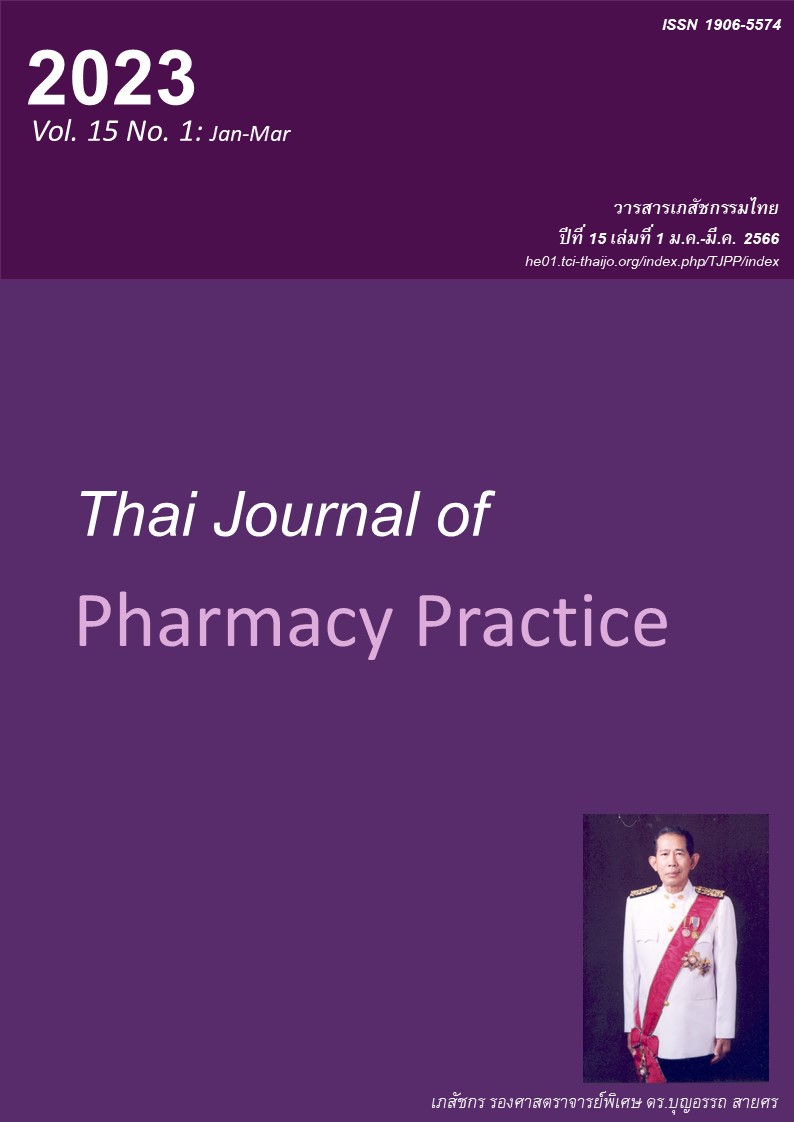การประเมินผล “โครงการร้านยาชุมชนอบอุ่น” ในจังหวัดร้อยเอ็ดด้วยแบบจำลองซิปป์
Main Article Content
บทคัดย่อ
วัตถุประสงค์ : เพื่อประเมินผลโครงการร้านยาชุมชนอบอุ่นจังหวัดร้อยเอ็ด วิธีการ: งานวิจัยแบบผสมผสานครั้งนี้ดำเนินการระหว่างกรกฎาคม-ธันวาคม 2563 การศึกษาเชิงคุณภาพเลือกผู้ให้บริการและผู้ป่วยแบบเจาะจง แบบสัมภาษณ์พัฒนาตามกรอบแนวคิดแบบจำลองซิปป์ การวิจัยใช้การสัมภาษณ์แบบออนไลน์ แบบพบหน้า และทางโทรศัพท์จนข้อมูลถึงจุดอิ่มตัว การศึกษาใช้การวิเคราะห์แก่นสาระ แบบสอบถามความพึงพอใจของผู้ป่วยพัฒนาขึ้นในการศึกษานี้ การวิจัยเลือกผู้ป่วยโดยกำหนดโควตาและสุ่มอย่างง่ายเพื่อประเมินความพึงพอใจ ผลการวิจัย : ผู้เข้าร่วมสัมภาษณ์เชิงลึกจำนวน 42 คน เป็นกลุ่มผู้ให้บริการ 27 คน และผู้ป่วย 15 คน ผู้ป่วยตอบแบบสอบถามความพึงพอใจจำนวน 80 คน การวิเคราะห์แก่นสาระพบว่า ด้านบริบทมี 3 แนวคิดหลัก คือ ระบบบริการสุขภาพ เป้าหมาย และความคาดหวังต่อโครงการ ด้านปัจจัยนำเข้ามี 4 แนวคิดหลัก คือ ทรัพยากรบุคคล รูปแบบการให้บริการ การประชาสัมพันธ์ และการเงิน ด้านกระบวนการมี 4 แนวคิดหลัก คือปัญหาด้านการรับรู้เป้าหมาย ด้านกำลังคน ด้านรูปแบบการให้บริการ และด้านการประชาสัมพันธ์ ด้านผลลัพธ์/ผลกระทบมี 5 แนวคิดหลัก คือ การยอมรับเภสัชกร จำนวนผู้ป่วยที่รับบริการจากร้านยา ความคุ้มค่า คุณภาพการให้บริการของเภสัชกร และความสะดวก ผลการศึกษาชี้ให้เห็นว่า โครงการต้องการลดความแออัดในโรงพยาบาล แม้ว่าจำนวนการส่งผู้ป่วยออกไปรับบริการที่ร้านยายังมีปริมาณต่ำกว่าเป้าหมาย ผู้ป่วยพึงพอใจโดยเฉลี่ยต่อบริการของร้านยาในระดับมากที่สุด (9.7+0.7) ผู้ป่วยได้รับบริการที่สะดวกสบาย เภสัชกรร้านยาช่วยแก้ไขปัญหาการใช้ยา บทบาทวิชาชีพเภสัชกรรมชุมชนได้ถูกส่งเสริมมากขึ้น ผลการศึกษายังชี้ให้เห็นส่วนที่ควรพัฒนาเพื่อการดำเนินงานถึงเป้าหมาย เช่น วิธีการคัดเลือกผู้ป่วย ระบบการกระจายยาไปยังร้านยา การประชาสัมพันธ์ การขยายจำนวนร้านยาให้ครอบคลุมพื้นที่ต่างอำเภอ การสร้างการยอมรับของแพทย์ต่องานของเภสัชกรร้านยา สรุป : โครงการนี้ตอบสนองความต้องการของพื้นที่ ควรได้รับการสนับสนุนการดำเนินงานต่อเนื่องและควรมีการพัฒนารูปแบบบริการให้ดีขึ้นต่อไป
Article Details

อนุญาตภายใต้เงื่อนไข Creative Commons Attribution-NonCommercial-NoDerivatives 4.0 International License.
ผลการวิจัยและความคิดเห็นที่ปรากฏในบทความถือเป็นความคิดเห็นและอยู่ในความรับผิดชอบของผู้นิพนธ์ มิใช่ความเห็นหรือความรับผิดชอบของกองบรรณาธิการ หรือคณะเภสัชศาสตร์ มหาวิทยาลัยสงขลานครินทร์ ทั้งนี้ไม่รวมความผิดพลาดอันเกิดจากการพิมพ์ บทความที่ได้รับการเผยแพร่โดยวารสารเภสัชกรรมไทยถือเป็นสิทธิ์ของวารสารฯ
เอกสารอ้างอิง
Anon. Get medicine at the drugstore. Help reduce congestion in the hospital? [online]. 2020 [cited May 10, 2020]. Available from: www.hitap.net/176056.
National Health Security Office. National Health Security Handbook 2010. Nonthaburi; 2010.
Upakdee N, Dhippayom T. Community pharmacy service under the national health insurance in Australia. Journal of Health Science 2015; 24: 182-94.
Eickholf C, Schulz M. Pharmaceutical care in community pharmacies: practice and research in Germany. Ann Pharmacother 2006; 40: 729-35.
Noyce PR. Providing patient care through community pharmacies in the UK: policy, practice and research. Ann Pharmacother 2007; 41: 861-68.
Westerlund LOT, Bjork HT. Pharmaceutical care in community pharmacies: practice and research in Sweden. Ann Pharmacother 2006; 40: 1162-69.
Hongsamut D, Arkaravichien W, Sangkar P, Jarupach C. Prescription review by community pharmacy joining community caring clinic under the National Health Security Scheme: A case study of Mahachai Community Caring Clinic Nakhon Ratchasima. Journal of Health Science 2009; 18: 251-61.
Arkaravichien, W., Hongsamout, D., Jarupach, C., & Sangkar, P. Activities reflecting quality of pharmacy services and satisfaction with the services: A case study of Maha Chai Community Caring Clinic Nakhon Ratchasima. Journal of Health Science 2018; 17: 1810-21.
Chalongsuk R, Lochind-amnuay S, Suntimaleewolagun W. A study of a refill prescription service system comparing a hospital pharmacy and an accredited pharmacy. Journal of Health Systems Research 2007; 1: 249-61.
Khumsikiew,J. , Arkaravichien,W. , Hongsamoot,D., Sangkar,P. Diabetes and hypertension screening by accredited community pharmacy in Khon Kaen under a pilot project with the National Health Security Scheme. Srinagarind Medical Journal 2009; 24: 215-23.
Sookaneknun P, Saramunee K, Rattarom R, Kong sri S, Senanok R, Pinitkit P et al. Economic analysis of the diabetes and hypertension screening collaboration between community pharmacies and a Thai government primary care unit. Prim Care Diabetes 2010; 4: 155-64.
Chaisong S. Osiri S, Hiranpanich W, Aphasrithong sakul S, Satyawongthip P. Primary care of pharma- cies in the health insurance system: a case study of university pharmacies. Nonthaburi: Institute for Health Systems Research; 2005.
Ministry of Health. Congestion reduction project operation manual of service units in the National Health Security System by current type 1drug stores [online]. 2019 [cited May 10, 2020]. Available from: www.pharcpa.com/index.php?page=news_detail&id=442
Phithiyanuwat S. Meeting project evaluation: Principles and applications. 2nd ed. Bangkok: Odeonstore; 1981.
Desu MM, Raghavarao D. Sample size methodology. Academic press: New York; 1990.
Maieiam S. Outcomes of medication therapy management in diabetic patients under hospital and community [master thesis]. Bangkok: Chulalongkorn University; 2011.
Piyasin K, Srisura N, Kessomboon N, Lertsinudom S. Outcomes of the project “Taking Medications Close to Your Home with Your Closed Pharmacists”: Khon Kaen Model. Thai Journal of Pharmacy Practice 2022; 14: 229-41.
Sumpanprateep, S. Evaluation the effectiveness of “Termya Termsuk” (Fill Pills, Fill Happiness) Project. Region 11 Medical Journal 2016; 2: 59–68.
Simtrakul W. Project evaluation of antihypertensive medication refill clinic by pharmacist at Si Prachan hospital [master thesis]. Nakhon Pathom: Silpakorn University; 2014.


